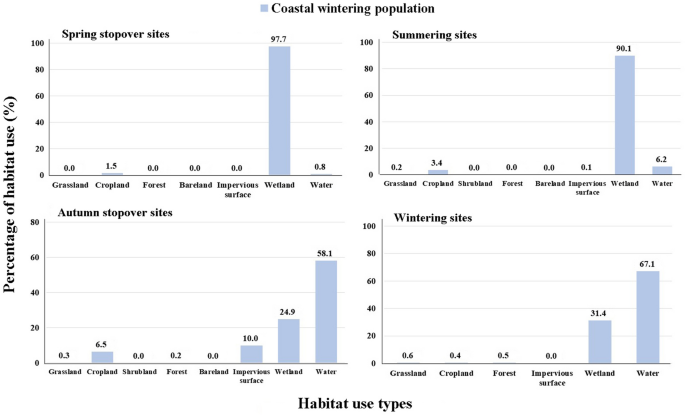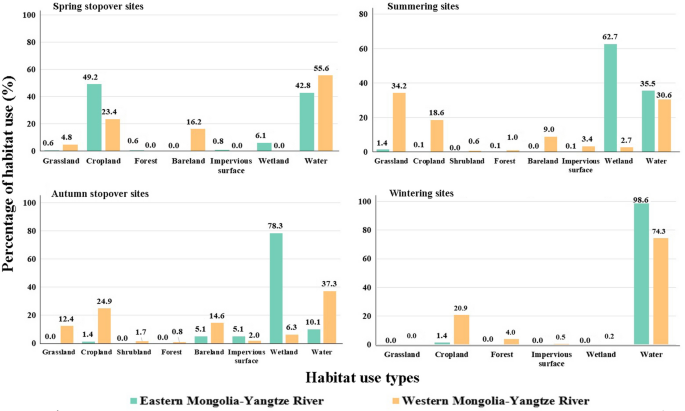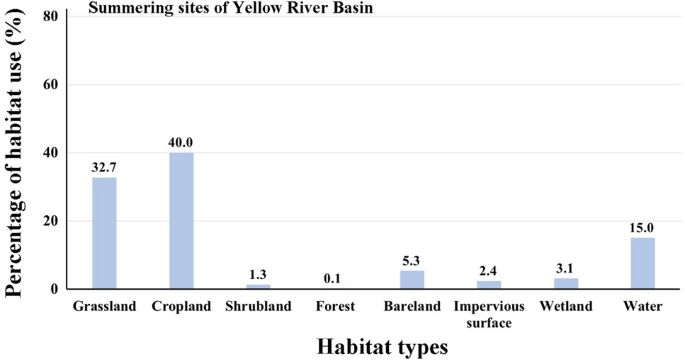Chinese wintering birds originate from at least three breeding areas
Based on the tracking data, Eurasian Spoonbills from the three different breeding provenances migrated separately to winter in two different parts of China. The four tagged birds that were marked in the Naoli River Basin (Heilongjiang Province, China) all wintered in coastal China (including around Yancheng, Lianyungang and Tai Lake in Jiangsu Province; Fig. 2). The remaining six birds caught at Uvs Lake (in western Mongolia) or Hulun Lake (in eastern Inner Mongolia) wintered in the middle and lower reaches of the Yangtze River floodplain, in Hubei, Jiangxi and Anhui Provinces (Fig. 3).
a East Asia map of the breeding (green) and wintering (blue) distribution of the Eurasian Spoonbill. b Enlarged map of the same detailed wintering area in China coast, showing autumn migration routes (N = 4 and stopover sites in green) and spring migration routes (N = 2 and stopover sites in pink). Circles with central black dots indicate capture sites, inverted triangles summering sites, regular triangles wintering sites and yellow dots show areas used during summer. The distribution data of the Eurasian Spoonbill are derived from Xi (2021)
a East Asia map of the breeding (green) and wintering (blue) distribution of the Eurasian Spoonbill. b Enlarged map of the same detailed wintering inland in China, showing the dichotomy between birds breeding in western Mongolia (autumn migration routes (N = 8); spring migration routes (N = 3)) and that caught at Hulun Lake, Inner Mongolia (autumn migration routes (N = 1); spring migration routes (N = 1)). Circles with central black dots indicate capture sites, inverted triangles summering sites, regular triangles wintering sites and yellow dots show areas used during summer, the black cross-hatched area represents the Yellow River Basin and the Yangtze River Basin. The distribution data of the Eurasian Spoonbill are derived from Xi (2021)
Autumn migration routes
We derived 13 complete autumn migrations from the 10 tagged Eurasian Spoonbills. Four tracked Eurasian Spoonbills (ES01, ES02, ES03, ES04) captured along the Naoli River Basin, Heilongjiang Province used Ussuri Bay (Primorsky Krai, Russia), Kanghwa Bay (Inchon, South Korea) or Haizhou Bay (Lianyungang, Jiangsu Province, China) as stopover sites (Fig. 2; Additional file 1: Table S2) and wintered along the Jiangsu coast. The mean migration distance was 2376 ± 161 km (standard deviation, SD).
The group that overwintered in the Yangtze River floodplain of China, originated from two different, but more westerly summering areas. The single tagged Eurasian Spoonbill (ES05) from the Wulanor wetland on Hulun Lake, Inner Mongolia departed and stopped at the Daling River (Chaoyang, Liaoning Province, China) and the Yellow River Delta in Bohai Bay during its autumn migration, and wintered at Poyang Lake in the Yangtze River Basin (Fig. 3; Additional file 1: Table S2). The migration distance was 2451 km. Complete migration data were available from five individuals (ES06, ES07, ES08, ES09, ES10) marked at Uvs Lake in western Mongolia. These birds commenced autumn migration from their summering habitat, stopping either in southern Mongolia, in the Yellow River Basin (Inner Mongolia and Shaanxi and Henan Provinces) or within the Yangtze River Basin (Hubei and Anhui Provinces). Of all these staging areas, the Yellow River Basin formed the core area for all the migration routes used by this group of birds from western Mongolia. The wintering areas of these birds were Poyang Lake (ES09), Dongting Lake (ES06, ES07), Liangzi Lake (ES08) and Caizi Lake (ES10) in the Yangtze River Basin in 2018/2019 winter (Fig. 3; Table 1). Their mean migration distance was 3466 ± 527 km (SD). Unfortunately, the signal from ES09 was lost in December 2018 in Inner Mongolia, China, and ES10 died or lost the transmitter in May 2019 in Anhui Province, China, which was close to its wintering area. Data from the remaining birds in subsequent years showed that these birds summered at Uvs Lake (western Mongolia), the Zavkhan and Ider Rivers, with one individual spending the summer on the Tuin River in central Mongolia (Fig. 3; Additional file 1: Table S2).
Three tagged juveniles hatched in western Mongolia (ES06, ES07, ES08) in 2018 changed their subsequent summer location (Fig. 3; Additional file 1: Table S2). In 2019, the three birds shifted their summer quarters from western Mongolia to central Mongolia and the Yellow River Basin (about 1300 km). Two of them (ES07, ES08) also changed their wintering location after autumn 2019. ES07 wintered at Dongting Lake, Hunan Province in the Yangtze in 2018/2019 but wintered in Henan Province in 2019/2020 (about 400 km to the east; Additional file 2: Fig. S2). ES08 wintered on Caizi Lake, Anhui Province in 2019/2020 winter after wintering at Liangzi Lake, Hubei Province (although both sites are within the Yangtze, c. 250 km apart) in 2018/2019 winter (Additional file 2: Fig. S3). In summary, all three surviving juveniles changed their summer places and shortened their migration distance.
Spring migration routes
We derived six complete spring migration episodes in 2019 from the ten Eurasian Spoonbills. Only two of the tagged Eurasian Spoonbills, which wintered along the coast at Yancheng, Jiangsu Province, survived to spring. They followed different spring migration routes but to the same ultimate summering area (along the Naoli River, near Shuangyashan City, Heilongjiang Province, China; Fig. 2; Table 1). ES01 flew along the coast, and staged for 2 days in Ussuri Bay (Primorsky Krai), Russia, while ES02 flew inland and staged for 22 days at Daqing and Kuerbin Reservoirs in Yichun, Heilongjiang Province, China. The mean migration distance was 2432 ± 590 km (SD).
The lone Inner Mongolian tagged individual, ES05, started its spring migration from its wintering site at Poyang Lake in the Yangtze River Basin, and staged at Bohai Bay and a reservoir in Tangshan, Hebei Province between 28 February and 12 April, before continuing back to Hulun Lake via Pingyuan Reservoir (Hebei Province; Fig. 3; Table 1). The migration distance was 2452 km.
Of the western Mongolian tagged birds, ES06, ES07 and ES08 commenced spring migration from the Yangtze River Basin (Fig. 3; Table 2), ES06 stopped midway in the Yellow River Basin (Shaanxi Province) for about 10 days, before returning to its summering area in the Yellow River Basin, Bayannur, Inner Mongolia (Additional file 2: Figure S1). ES07 staged in the Yellow River Basin (Shanxi Province) for about 15 days and 2 further days in the southern Gobi region of Mongolia, finally summering along the Tuin River in central Mongolia. ES08 flew from its Dongting Lake wintering site directly to its summering place in the Yellow River Basin (Baotou, Inner Mongolia) without stopping (Fig. 3; Table 2). The mean migration distance was 1897 ± 500 km (SD).
Autumn migration parameters
We summarized migration parameters in different migration routes (Table 1), as we tagged only one bird in Inner Mongolia, China, here we only make comparisons between birds caught along the Naoli River in Heilongjiang Province, China, and those in western Mongolia.
Among these birds, autumn migration started from late August to the end of October. Naoli River individuals left their summering area in mid-October, arriving to their coastal Jiangsu Province wintering areas in late November to mid-December. All Naoli River birds left their breeding areas more or less simultaneously in 2016 between 19 and 22 October. Western Mongolian birds left their summer areas earlier between 22 August and 5 October in 2017 and 2018. However, the same individuals left later in 2019, when they also arrived at their ultimate wintering site significantly earlier in later October compared to 2018, when almost all arrived in November. This was because they undertook a much shorter overall migration in that year, having summered at sites well south of where they had previously been captured. In 2019, three western Mongolian individuals did not return to their place of hatching, so their migration distance was almost half of that in autumn 2018 (Table 1).
Naoli River birds undertook significantly shorter migration routes than western Mongolian tagged birds (Wilcoxon rank-sum test, P < 0.05) but the difference in migration duration did not differ significantly (Table 3). Western Mongolia tagged birds made twice the number of stopovers taken by Naoli River birds (a statistically significant difference, Wilcoxon rank-sum test, P < 0.05) although the stopover duration did not differ significantly between the two groups (Table 3). Overall, migration speed, daily travel speed and straightness index did not differ between the two routes.
Spring migration parameters
The start of Far East Asian Eurasian Spoonbill spring migration extended from mid-February to mid-May (Table 2). Naoli River tagged individuals left their coastal wintering area between 10 and 16 May and arrived at their summering areas between 23 May and 15 June.
Western Mongolian tagged birds started migration between 1 and 17 May, arriving at the summering areas between 2 May and 9 June (Table 2), which did not differ significantly from Naoli River tagged individuals. Overall, migration distance, daily travel speed and straightness index did not differ between the two routes.
In contrast, the single tagged in Inner Mongolia began spring migration on 13 February and arrived at the summering area on 16 April (Table 2), a migration duration of 61.4 days, significantly greater than all other individuals, due to more frequent stopovers and longer stopover duration.
Stop sites
We identified 45 stop sites, including 35 during autumn migration and 10 during spring migration. None of these stop sites used in autumn were used as stop sites by any individuals again in the following spring migration, suggesting these were of less importance than stopover sites. Among them, Mongolia (11 sites) and Henan Province (7 sites), China, and Inner Mongolia (7 sites) of China were the most used areas (Table 4).
Habitat use
Habitat use differed between migration routes (Figs. 4, 5, 6; Additional file 1). Throughout the annual cycle, more than 90% of habitat types used by Eurasian Spoonbills tracked in Naoli River were wetlands and open waters combined. The same was true for the single Inner Mongolian tagged bird, except at spring stopover areas, where it exploited 49% cropland. Western Mongolian tagged birds used 19–25% cropland throughout the year and 34% grassland in summer, proportionally less open water (varying between 74% in winter and 31% in summer).
Use of protected areas
All tagged individuals used spring stopover sites that lacked protection (Fig. 7; Additional file 1: Table S4). Naoli River and the Inner Mongolian birds used sites throughout the rest of their annual life cycle which seemed well protected (> 49%). Birds tagged in western Mongolia also exploited areas that were relatively poorly protected (19–21% for summering and wintering areas, but only 5% for autumn stopover areas).
Maps showing the current extent of protected areas (outlined in purple, with those used by birds shown in darker purple) used by telemetry tagged Eurasian Spoonbills (indicated by different coloured dots) marked at the three discrete breeding areas. Left maps show summer distributions, right maps show the situation in winter in China. Top maps (a1 and a2) show the summering and wintering areas of birds that summered in western Mongolian, middle maps (b1 and b2) show the summering and wintering areas of birds that summered in Inner Mongolia, and lower maps (c1 and c2) show the summering and wintering areas of birds that wintered in Jiangsu coast, China. Green dots represent individual positions of birds marked in western Mongolia; yellow dots represent the bird marked in Inner Mongolia; red dots represent those wintering along the Jiangsu coast of China
Naoli River tagged Eurasian Spoonbills spent 73.0% of time on summering sites located within protected areas (Fig. 7; Additional file 1: Table S4), mostly in the Naoli River and Sanjiang National Nature Reserves. During autumn migration, these birds spent 62.0% of their stopover time within the Xingkai Lake National Nature Reserves, and 80.9% of time on wintering sites within the Yancheng National Nature Reserve.
The tracked Inner Mongolia Eurasian Spoonbill spent 94.8% of time within protected areas during the summer period (Fig. 7; Additional file 1: Table S4), almost all within the Hulun Lake and Hui River National Nature Reserves. During autumn stopovers, 48.5% of positions were located within Yellow River Delta National Nature Reserve, and 70.8% in winter period, the majority from the Poyang Lake National Nature Reserve (Fig. 7; Additional file 1: Table S4).
Tracking positions from western Mongolia Eurasian Spoonbills on the summering grounds were relatively rarely (19.2%) from within Uvs Nuur Basin Biosphere Reserve and Valley of Lake Reserve, and just 4.9% of the sites used as autumn stopover sites fell within Ordos Relict Gull National Nature Reserve. In winter, 21.8% of the sites were located in protected areas, mainly within East Dongting Lake National Nature Reserve, Shengjin Lake National Nature Reserve, Poyang Lake National Nature Reserve and Tongling Freshwater Dolphin National Nature Reserve.










Add Comment